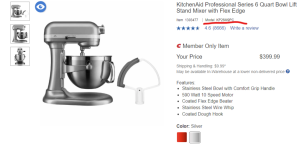since people probably won't clickthrough to read:
Customer Review

Stefan Brunner
5.0 out of 5 stars The difference between the 600, 610, 620, 6000, 6500, 7 qt, 8 qt models
Reviewed in the United States

on May 17, 2017
Verified Purchase
When I bought the recent Costco model, I was intrigued to find out what was hiding behind the Costco brand Kitchenaid model. Interestingly enough, it turns out to be a Williams-Sonoma 610 model. This got me asking what is the difference to the 600 model, and why does a 610 model even exist? After taking my Costco model apart, doing a significant amount of research, and acquiring the 7 qt model and investigating it, I came to the following conclusion:
All models, the 600, 610, 620, 6000, 6500, 7qt residential, 7 qt commercial, and 8 qt are essentially all the same models. They have the exact same form factor and with the exception of the 6000, fit the same beaters and bowls. They differ mainly in motor, transmission, bowl, and beater (that needs to match bowl size). And some models have plastic knobs whereas other have metal ones.
600: This is the base model. A few years ago Kitchenaid changed the transmission case, that holds some sprockets in place, to plastic. This was changed back to the old metal cast case from the 6 Series now. It has a 575W AC motor.
610: Is the same as the 600 with the same transmission, but a different 590W AC motor. I doubt that the extra 15W this motor is rated for makes a difference. The 600 model collected a lot of critic from people doing heavy doughs. My assumption is that Williams-Sonoma requested a more robust motor, perhaps with higher torque. The control electronic is a very simple triac motor control. It looks similar to the 600 control, but has the hall speed sensor soldered on. It also misses the IC from early 600 models. The wire whip is not the one from the 600, but the one from the 7 and 8 qt models. The Costco model has metal flat and hook beaters instead of the coated ones.
620: Is a 610 in fancy colors.
6000 HD: It has an entirely different transmission and motor than the 600, 610, or 620. My assumption is that the transmission is the same as in the 6500, 7qt and 8 qt models. The motor may or may not be the same. The 6000, like the 6500, is rated as 1 HP. It could be the same motor from the 7 qt and 8 qt and might be electronically limited or simply derated on paper. The bowl, and therefore the beaters, are totally different than on the 600 models. The bowl is taller and narrower. Because the pins that hold the bowl are narrower, you can only fit 6000 bowls, but not those from the 600, 6500, or 7 qt, 8 qt models. This is by the way also the old Costco model.
6500: Appears to be a 7 qt model, derated for 1 HP with a fancy 6 qt bowl. The cover of the planetary gear facing the bowl looks more robust.
7 qt: Its motor is rated for 1.3 HP. The 7 qt appears to fit all the bowl from the 600, I actually tried this out, even with 7 qt beaters. In reverse, the 600 fits bowl and beater of the 7 qt.
8 qt: In all likelihood a 7 qt model with a bigger bowl and a finger guard. Motor is rated the same. It should fit all 7 qt and 600 model bowls.
The 7 qt and 8 qt also exist as commercial versions with an orange power cord and a commercial use warranty. Otherwise, my assumption is that they are the same as the residential models.
Confused, yet? What should you pick?
In my opinion the biggest differentiator is the AC vs DC motor, not because the motor is AC or DC, but because of torque, transmission, and speed control design. The DC motor of the 6000, 6500, 7 qt, and 8 qt models is significantly beefier than the one of the 600 Series. The DC motor uses a digital PWM speed control that holds speed exactly and increases torque as needed. The 6000 and 6500 may or may not have the same motor as the 7 qt and 8 qt models, but are rated with 25% less power. As I said, this might be paper derated or electronically limited, or actually it has a slightly smaller motor. The DC models also are significantly quieter than the transmission and motor combo of the 600.
The 600, 610, and 620 use a very primitive triac control. The 610 and 620 have a slightly more robust motors but use the same transmission as the 600. The triac control will not increase torque as well while holding speed, which specifically will be noticeable with heavy doughs. These models are very noisy. Because of their simpler design, the 600 Series is cheaper to repair than the DC models. Sprockets are a couple of bugs and even the speed control is inexpensive.
The 6000 HD appears to be the oddball when it comes to bowls. It uses narrow bowls that need their own narrower beaters.
All other models use the same bowls. Now, it might make little sense to put an 8 qt bowl into a 600 where the motor is not strong enough. The dough hook might be the same, but you need more force. The wire whip has more wires on the 610 and up models. I do not see why it should not work on the 600. The real difference is in the flat beater. While you mostly can use the larger (flat) beaters with smaller bowls, like use a 7 qt beater with a 6 qt bowl, if you use a 6 qt beater with a 7 qt bowl, you just do not reach the top of the bowl. The 3 qt bowl should fit all models, even the 6000 model, because it has holes for the narrower pins, and comes with its own beater.
The dough hook exist in stainless, aluminum and coated aluminum. The flat beater exist as stainless, aluminum, coated aluminum, or with a silicon lip that saves you from interrupting and scraping the bowl walls. The wire whip is always stainless. Only stainless and coated aluminum can be washed in the dish washer. Some people complain about the coating flaking over time. While various packets exist that bundle coated or none coated versions, only the commercial 7 qt and 8 qt version contain stainless beaters. Beaters are quiet pricey but can purchased after market, even from third parties.
Depending on the sale you are getting, the price difference between the models might not be actually that much. I would not get a 6000 because of the weird bowl shape that locks you in. I found the price difference between the 7 qt and 600 models to be about $100 with the right deal, the 6500 actually could be more expensive. The 600 comes in all kinds of colors, of this is important to you. All other models are limited in colors. I decided for the 7 qt model because I wanted to make pizza and bread doughs and simply bought 5 qt and 3 qt bowls for the smaller jobs. I would buy an 8 qt bowl if I ever needed it.
I hope this information makes it easier for you to make your own decision.
On the picture, left the 7 qt model, and right the Costco 610 model.



